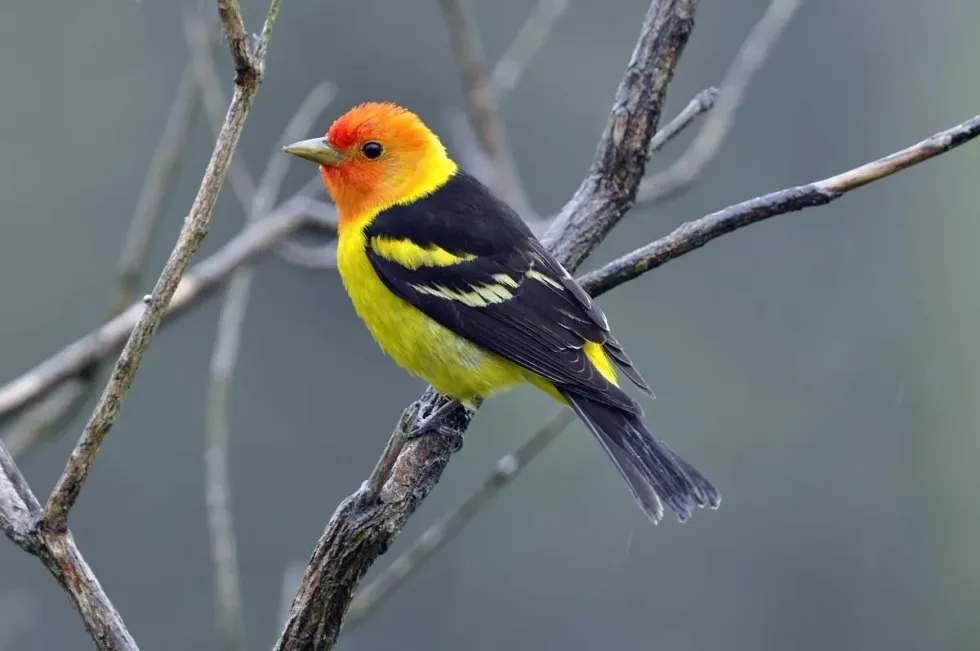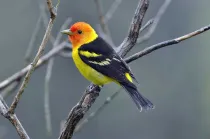The western tanager 'Piranga ludoviciana', are named so as they have been found in large numbers around the western regions of the conifer forests and open woodlands. Although these birds were earlier considered to be a part of the Thraupidae family of Tanager species, today these birds belong to the order Passeriformes family of Cardinalidae.
These colorful birds do not have red pigmentation by birth. The red color is something that they get because of the insects that they eat over the period of time.
These colorful birds are known to live alone or in pairs and they have a monogamous reproductive nature.
The migration of these birds takes place during the winter season that follows their breeding season. Unlike many other birds, the male birds of this species are not known to perform any specific acts or actions to attract the females to be their partners.
For more information and facts about other birds, check pileated woodpeckers and yellow warblers.
Western Tanager Interesting Facts
What type of animal is a Western Tanager?
Western tanagers belong to the bird species of animals.
What class of animal does a Western Tanager belong to?
The western tanager bird belongs to the Aves class of animals that consist of warm-blooded vertebrates.
How many Western Tanagers are there in the world?
Although these birds are listed under the Least Concern group of conservation, the exact number of their population in the world is unknown, however, their numbers are rising.
Where does a Western Tanager live?
Western tanagers belong to the order Passeriformes family of the Cardinalidae. They are densely populated North American birds.
They travel and reside in the forests of North America, Central America, northwest territories of Canada, Nebraska, and Texas. Their population from the northwest territories of Canada and the other regions is known to follow the migration cycle that shifts to the south during the winter.
What is a Western Tanager's habitat?
These birds are mainly found in open coniferous and mixed forests or woodland that are closer to lakes, parks, deserted oases, and pine-oak forests where they can find a good amount of food, mostly insects.
Who do Western Tanagers live with?
This species of bird is known to belong to the monogamous breeding group. That means the female and the male western birds live together during the breeding season.
They might live alone or with their partners. Although, during the migration time these birds prefer traveling in their small groups called flocks. They are also known to form groups with other species of birds.
How long does a Western Tanager live?
Western tanagers, the fame of South and North America do live a long life. They are said to have a lifespan of around one to 15 years in the wild as well as in captivity.
How do they reproduce?
The breeding season for these birds is between mid-April and mid-August. If the female and the male western tanager meet during winter, they usually follow the migration cycle together and travel to the breeding ground.
This species' breeding usually happens in the open coniferous forests. The female western tanager builds the nest with dry grass and sticks.
During the breeding, the female lays anywhere between one to five eggs. The time taken for laying one egg is one whole day. After laying all the eggs, the female alone incubates the eggs in the nest for a span of 13 days.
During this period, the male is to protect the nest and feed the female too. After the baby hatches, the male and female both take care of the newborn for two weeks post which the young one is ready to live its life independently outside the nest.
What is their conservation status?
As per the International Union for Control of Nature or the IUCN Red List, the western tanagers are listed as Least Concern amongst the other North American birds.
Western Tanager Fun Facts
What do Western Tanagers look like?

These birds are small in size with a good mix of bright colors. The male and the female bird can be identified based on their color differences.
The adult male usually has a bright yellow chest, an orange-red head with black wings. Their wings have two wing bars in yellow. The females are faded in color and usually have an olive green-colored head and brownish wings with a light shade of yellow or brown wing bars on both wings.
Both of them have a medium-thick and short bill. Their eyes are beady and both have a fan-shaped tail.
How cute are they?
Western tanagers, especially males, have bright colors like yellow, red, and orange. Their sweet sound and bright colors make them attractive and cute for the human eye.
How do they communicate?
The communication channel for this species is mainly acoustic. They use the western tanager song to communicate with their kind. They are also tactile and try to communicate with touch, visuals, and different chemical smells from their surroundings as perceptive means for communicating with the partners of their young ones in the nest.
How big is a Western Tanager?
These birds are five to six times bigger than the bee hummingbird, which is the smallest of the bird species. The western tanagers grow anywhere between 6.3- 7.5 in (16-19 cm). They might appear a bit bigger while flying as their wingspan can be as long as 11-11.8 in (28-30 cm) on the whole.
How fast can a Western Tanager fly?
Although these birds are known to carry out their migration at a higher altitude, the exact calculations about their speed are as yet unknown.
How much does a Western Tanager weigh?
The western tanager birds belong to a small-sized bird group and usually weigh between 0.9 oz to a maximum of 1.3 oz.
What are their male and female names of the species?
This species of birds are named western tanagers irrespective of their gender. The male and female birds are usually recognized by their different shades of yellow, red, and black rather than different names.
What would you call a baby Western Tanager?
Although the term chick is commonly used for most young birds, the baby of this bird is called a nestling just like the other similar species.
What do they eat?
Western tanagers are birds that usually depend on their hawking skills to obtain food. They are omnivores or one can even say that they are insectivores as they eat all kinds of insects.
They eat wasps, vespid, grasshoppers, wasps, cicadas, vespid, beetles, termites, and Douglas fir tussock moth larvae. Apart from these, the birds also feed on berries, fruits, Russian olive fruit, and hawthorn apples, especially during the winter season. While attracting them to the yards, humans can provide them with dried fruits, budworms, and bird seeds.
Are they dangerous?
These are small birds and have not posed any threat to humans. Hence, they aren't considered to be dangerous.
Would they make a good pet?
Western tanager Piranga ludoviciana, are known to be outdoor birds who love to live in open areas. Hence, this species of bird does not make a good pet with an indoor cage or nest.
Did you know...
The songs by these western tanagers sound like the American robin. Their soft vocalization of three to seven notes in short phrases is similar to that of the American robin songs.
Even though this species is known to be of the least concern, all species of tanager birds are rare around the world.
The Western Tanager's call
The birds have short phrases of three to five notes that consist of rattling or chuckling calls. These calls are used by the males and females as well as their young ones.
The sound of their babies has a musical tone to it whereas the females have comparatively less expressive sounds.
The males are known to understand the nervous calls of the females when they feel threatened. That is when the male bird reciprocates with a loud series of playback nervous calls and performs an act of flying from one branch to another.
How to attract Western Tanagers
As these birds do not make good pets, it is a tricky task to attract them to the households. Instead, you can attract them to open yards or surroundings around the wooded houses with the help of food.
Keeping fresh fruits or dried fruits in the yards near small ponds or in the tree nest boxes or feeders is the best way to attract this bird.
Here at Kidadl, we have carefully created lots of interesting family-friendly animal facts for everyone to discover! Learn more about some other birds including the painted bunting and the blue and yellow macaw.
You can even occupy yourself at home by drawing one of our western tanager coloring pages.










